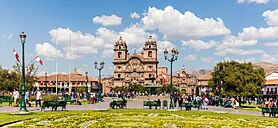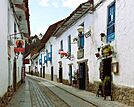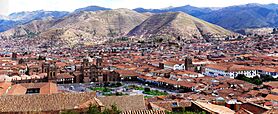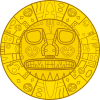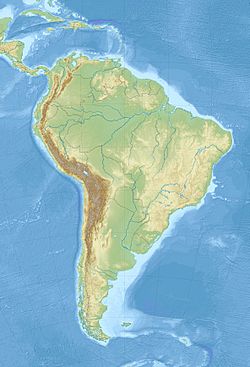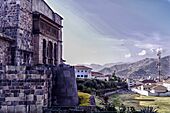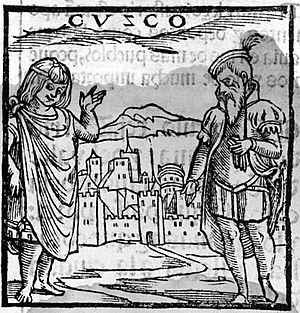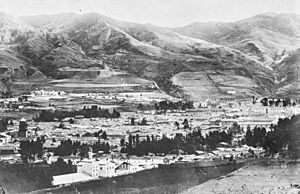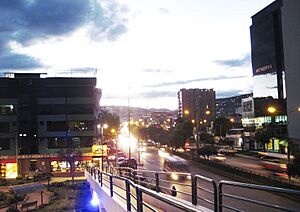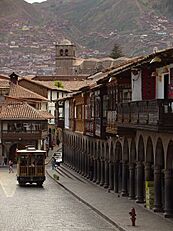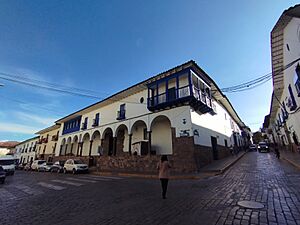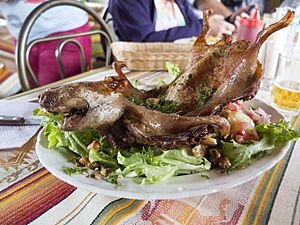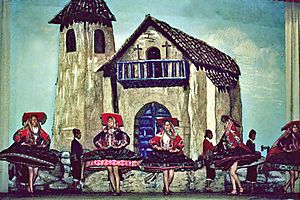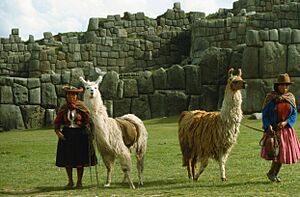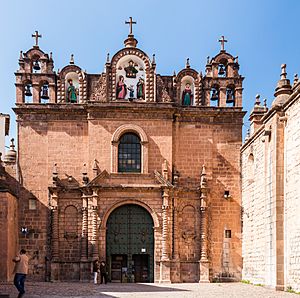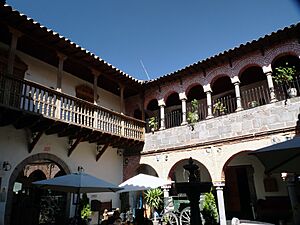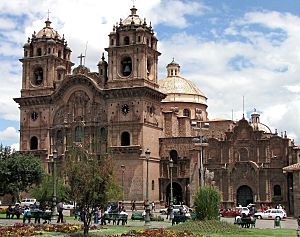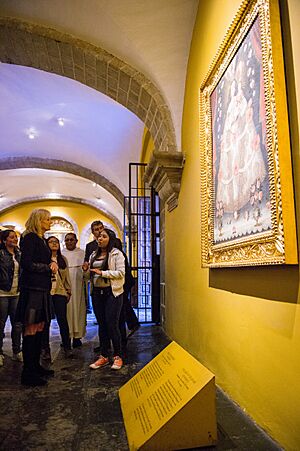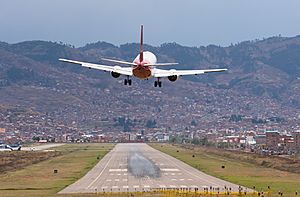Cusco facts for kids
Quick facts for kids
Cusco
|
|||||||||||||||
|---|---|---|---|---|---|---|---|---|---|---|---|---|---|---|---|
| Cusco or Cuzco Qosqo or Qusqu (Quechua) |
|||||||||||||||
|
|
|||||||||||||||
|
|||||||||||||||
| Nickname(s):
La Ciudad Imperial (The Imperial City), El Ombligo del Mundo (The Navel of the World)
|
|||||||||||||||
| Anthem: Himno del Cusco Qosqo yupaychana taki (English: "Anthem of Cusco") |
|||||||||||||||
| Country | Peru | ||||||||||||||
| Region | Cusco | ||||||||||||||
| Province | Cusco | ||||||||||||||
| Founded | March 23, 1534 | ||||||||||||||
| Founded by | Francisco Pizarro | ||||||||||||||
| Area | |||||||||||||||
| • Total | 385.1 km2 (148.7 sq mi) | ||||||||||||||
| Elevation | 3,399 m (11,152 ft) | ||||||||||||||
| Population
(2017)
|
|||||||||||||||
| • Total | 428,450 | ||||||||||||||
| • Estimate
(2015)
|
427,218 | ||||||||||||||
| • Density | 1,112.57/km2 (2,881.5/sq mi) | ||||||||||||||
| Demonym(s) | cuzqueño/a, cusqueño/a | ||||||||||||||
| Demographics | |||||||||||||||
| • Ethnic groups |
|
||||||||||||||
| GDP (PPP, constant 2015 values) | |||||||||||||||
| • Year | 2023 | ||||||||||||||
| • Total | $4.2 billion | ||||||||||||||
| Time zone | UTC-5 (PET) | ||||||||||||||
| • Summer (DST) | UTC-5 | ||||||||||||||
| UBIGEO |
08000
|
||||||||||||||
| Area code(s) | 84 | ||||||||||||||
|
|||||||||||||||
Cusco or Cuzco is a famous city in southeastern Peru. It is located near the Sacred Valley in the Andes mountains. Cusco is the capital of its own province and department. It is the seventh largest city in Peru, with about 428,450 people living there in 2017. The city is very high up, about 3,400 meters (11,155 feet) above sea level.
Cusco was once the capital of the powerful Inca Empire from the 1200s until the Spanish arrived in the 1500s. In 1983, UNESCO named Cusco a World Heritage Site, calling it the "City of Cusco". Today, it is a huge tourist spot, welcoming over 2 million visitors each year. It's also the gateway to many amazing Inca ruins, like Machu Picchu, which is one of the Seven modern wonders of the world. Peru's constitution even calls Cusco the Historical Capital of Peru. People sometimes call it the Rome of America.
Contents
- What's in a Name? The Story of Cusco's Spelling
- Cusco's Past: A Journey Through Time
- Cusco's Location and Weather
- Who Lives in Cusco?
- Cusco's Economy and Tourism
- Cusco's Culture and Traditions
- Amazing Places to See in Cusco
- Getting Around Cusco
- Healthcare in Cusco
- Cusco's Sister Cities
- Images for kids
- See also
What's in a Name? The Story of Cusco's Spelling
The original name of this city in the Quechua language is Qusqu. This name comes from the Aymara language and means 'rock of the owl'. It's linked to an old legend about how the city was founded.
The legend says that a hero named Ayar Awqa grew wings and flew to the spot where Cusco would be built. He then turned into a rock to claim the land for his family.
When the Spanish arrived, they wrote the name as Cuzco or Cozco. Cuzco became the common spelling in official papers for a long time.
Later, in 1976, the city decided to change the official spelling to Cusco. Then, in 1990, local leaders tried to use Qosqo, which is closer to the original Quechua. However, this spelling wasn't kept by future leaders.
Today, you might see both "Cusco" and "Cuzco" used, especially in English books. The city's international airport code is CUZ, which uses the older Spanish spelling.
Cusco's Past: A Journey Through Time
Kingdom of Cusco, 1197–1438
![]() Inca Empire, 1438–1532
Inca Empire, 1438–1532
![]() Spanish Rule, 1532–1821
Spanish Rule, 1532–1821
![]() Protectorate of Peru, 1821–1822
Protectorate of Peru, 1821–1822
![]() Peru, 1822–1836
Peru, 1822–1836
![]() Peru–Bolivian Confederation, 1836–1839
Peru–Bolivian Confederation, 1836–1839
![]() Peru, 1839–present
Peru, 1839–present

Early People: The Killke Culture
Before the Inca, the Killke people lived in the Cusco area from about 900 to 1200 CE. They built the fortress of Saksaywaman around 1100 CE. The Inca later took over and expanded this impressive site.
In 2008, archaeologists found the ruins of an old temple, a road, and a water system at Saksaywaman. This temple was very large and likely held idols and mummies, showing it was a religious place.
The Inca Empire: Cusco as its Heart
Cusco was a very important city for the native people of the region. It became the capital of the Inca Empire (from the 1200s to 1532). Many believe the city was designed to look like a puma, which was a sacred animal to the Inca.
The Inca built the city with amazing skill. They used huge stones that fit together perfectly without mortar. The city was divided into two main parts, hurin and hanan, which connected to the four main regions of the empire.
Each local leader had to build a house in Cusco and live there for part of the year. This helped the Inca rulers keep control over their vast empire.
The Sapa Inca Pachacuti is often credited with rebuilding Cusco and turning the Inca kingdom into a huge empire called Tawantinsuyu. However, archaeological findings suggest the city grew slowly over time, even before Pachacuti's rule.
In 1532, during a civil war, Cusco was captured by the generals of Atahualpa. Just 19 months later, Spanish explorers arrived, took control of the city, and ended the Inca Empire.
Spanish Rule: A New Era for Cusco
The first Spanish soldiers arrived in Cusco in May 1533. On November 15, 1533, Francisco Pizarro officially entered the city. The Spanish were amazed by Cusco's beautiful buildings and well-planned streets.
The Spanish destroyed many Inca buildings, temples, and palaces. They used the strong Inca walls as foundations for their new churches and homes. This is why you can still see a mix of Spanish and Inca building styles in Cusco today.

Pizarro renamed the city the "very noble and great city of Cuzco." He encouraged his men to settle there. The first mayor and council members were chosen in March 1534.
In 1536, Manco Inca Yupanqui, an Inca leader, tried to take Cusco back from the Spanish. The siege lasted 10 months, but he was not successful. Many Incas also died from diseases like smallpox that the Europeans brought.
Cusco became a key center for the Spanish to spread Christianity in the Andean region. The city grew rich from farming, raising animals, mining, and trading with Spain. The Spanish built many churches, convents, a cathedral, and a university.
Cusco Today: A Modern City with Ancient Roots

In 1950, a big earthquake hit Cusco, damaging many buildings. However, the strong Inca walls, like those of the Qurikancha (Temple of the Sun), survived the earthquake. This showed how well the Inca built their structures.
In the 1990s, Mayor Daniel Estrada Pérez worked to make the city even more beautiful. He restored old monuments and built new plazas. Thanks to his efforts, Cusco was declared the "Historical Capital of Peru" in 1993.
Today, Cusco is Peru's most important tourist spot. Recent events like the COVID-19 pandemic in Peru and protests have affected tourism, but the city remains a popular destination.
Honors and Recognitions
Cusco has received many special titles over the years:
- In 1933, it was called the Archeological Capital of the Americas.
- In 1978, it was named a Cultural Heritage of the World.
- In 1983, UNESCO declared it a World Heritage Site. The Peruvian government also called it the Tourism Capital of Peru and Cultural Heritage of the Nation.
- In 2001, it was given the title of Historical Capital of Latin America.
- In 2007, it was named the Cultural Capital of America.
- Also in 2007, Machu Picchu, near Cusco, was chosen as one of the New Seven Wonders of the World.
Cusco's Location and Weather

Where is Cusco Located?
Cusco is in the Huatanay (or Watanay) river valley. It sits at the eastern end of the Knot of Cusco, about 3,400 meters (11,155 feet) above sea level. To the north are the Vilcabamba mountain range with mountains that are 4,000 to 6,000 meters (13,123 to 19,685 feet) high. The highest peak nearby is Salcantay, which is about 6,271 meters (20,574 feet) tall.
What is Cusco's Climate Like?
Cusco has a mild and generally dry climate with two main seasons.
- Winter (April to September): This season has lots of sunshine and sometimes gets cold enough for frost at night. July is the coldest month.
- Summer (October to March): This season is warmer and has a lot of rain. November is the warmest month.
It rarely snows in Cusco; the last snowfall was in 1911. Temperatures usually range from 0.2°C to 20.9°C (32.4°F to 69.6°F). Cusco is known for having very high levels of ultraviolet light.
| Climate data for Cusco (Alejandro Velasco Astete International Airport) 1961–1990, extremes 1931–present | |||||||||||||
|---|---|---|---|---|---|---|---|---|---|---|---|---|---|
| Month | Jan | Feb | Mar | Apr | May | Jun | Jul | Aug | Sep | Oct | Nov | Dec | Year |
| Record high °C (°F) | 27.8 (82.0) |
26.7 (80.1) |
25.3 (77.5) |
26.9 (80.4) |
27.0 (80.6) |
24.2 (75.6) |
24.2 (75.6) |
25.8 (78.4) |
25.9 (78.6) |
27.2 (81.0) |
26.6 (79.9) |
29.9 (85.8) |
29.9 (85.8) |
| Mean daily maximum °C (°F) | 18.8 (65.8) |
18.8 (65.8) |
19.1 (66.4) |
19.7 (67.5) |
19.7 (67.5) |
19.4 (66.9) |
19.2 (66.6) |
19.9 (67.8) |
20.1 (68.2) |
20.9 (69.6) |
20.6 (69.1) |
20.8 (69.4) |
19.8 (67.6) |
| Daily mean °C (°F) | 12.9 (55.2) |
12.7 (54.9) |
12.8 (55.0) |
12.7 (54.9) |
12.0 (53.6) |
11.4 (52.5) |
10.8 (51.4) |
11.5 (52.7) |
12.7 (54.9) |
13.6 (56.5) |
13.6 (56.5) |
13.2 (55.8) |
12.5 (54.5) |
| Mean daily minimum °C (°F) | 6.6 (43.9) |
6.6 (43.9) |
6.3 (43.3) |
5.1 (41.2) |
2.7 (36.9) |
0.5 (32.9) |
0.2 (32.4) |
1.7 (35.1) |
4.0 (39.2) |
5.5 (41.9) |
6.0 (42.8) |
6.5 (43.7) |
4.3 (39.7) |
| Record low °C (°F) | 0.0 (32.0) |
0.0 (32.0) |
0.0 (32.0) |
−2.0 (28.4) |
−7.0 (19.4) |
−4.5 (23.9) |
−7.0 (19.4) |
−6.0 (21.2) |
−6.0 (21.2) |
0.0 (32.0) |
0.0 (32.0) |
0.5 (32.9) |
−7.0 (19.4) |
| Average rainfall mm (inches) | 160.0 (6.30) |
132.9 (5.23) |
108.4 (4.27) |
44.4 (1.75) |
8.6 (0.34) |
2.4 (0.09) |
3.9 (0.15) |
8.0 (0.31) |
22.4 (0.88) |
47.3 (1.86) |
78.6 (3.09) |
120.1 (4.73) |
737 (29) |
| Average rainy days (≥ 1.0 mm) | 19 | 15 | 13 | 9 | 2 | 1 | 1 | 2 | 5 | 9 | 13 | 16 | 105 |
| Average relative humidity (%) | 66 | 67 | 66 | 63 | 59 | 55 | 54 | 54 | 56 | 56 | 58 | 62 | 60 |
| Mean monthly sunshine hours | 143 | 121 | 170 | 210 | 239 | 228 | 257 | 236 | 195 | 198 | 195 | 158 | 2,350 |
| Source 1: NOAA, Meteo Climat (record highs and lows) | |||||||||||||
| Source 2: Deutscher Wetterdienst (mean temperatures 1961–1990, precipitation days 1970–1990 and humidity 1954–1993) Danish Meteorological Institute (sun 1931–1960) | |||||||||||||
| Climate data for Cusco (Granja Kayra), elevation 3,214 m (10,545 ft), (1991–2020) | |||||||||||||
|---|---|---|---|---|---|---|---|---|---|---|---|---|---|
| Month | Jan | Feb | Mar | Apr | May | Jun | Jul | Aug | Sep | Oct | Nov | Dec | Year |
| Mean daily maximum °C (°F) | 20.2 (68.4) |
20.2 (68.4) |
20.4 (68.7) |
20.9 (69.6) |
21.3 (70.3) |
20.9 (69.6) |
20.8 (69.4) |
21.5 (70.7) |
21.9 (71.4) |
21.9 (71.4) |
22.2 (72.0) |
20.9 (69.6) |
21.1 (70.0) |
| Mean daily minimum °C (°F) | 7.4 (45.3) |
7.5 (45.5) |
6.8 (44.2) |
4.4 (39.9) |
1.0 (33.8) |
−0.8 (30.6) |
−1.3 (29.7) |
0.5 (32.9) |
3.3 (37.9) |
5.4 (41.7) |
6.3 (43.3) |
6.9 (44.4) |
4.0 (39.1) |
| Average precipitation mm (inches) | 145.8 (5.74) |
126.4 (4.98) |
97.3 (3.83) |
33.1 (1.30) |
6.3 (0.25) |
3.7 (0.15) |
4.2 (0.17) |
5.2 (0.20) |
14.5 (0.57) |
43.6 (1.72) |
71.1 (2.80) |
114.9 (4.52) |
666.1 (26.23) |
| Source: National Meteorology and Hydrology Service of Peru | |||||||||||||
Who Lives in Cusco?
In 2017, Cusco had a population of about 428,450 people.
| Ethnicities of Cusco in 2017 | ||||
|---|---|---|---|---|
| Ethnicities | Percentage | |||
| Quechua | 63.0% | |||
| Mestizo | 31.0% | |||
| White | 1.9% | |||
| Other indigenous groups | 1.0% | |||
| Other | 0.8% | |||
| No answer | 2.3% | |||
Most people in Cusco speak Spanish, but the native language is Quechua. The Quechua people are the last living descendants of the Inca Empire.
Cusco's Economy and Tourism
Cusco's economy includes farming, especially corn and native potatoes. There are also local industries that make food and drinks like beer and coffee.
However, the most important part of Cusco's economy is Tourism. It has been the main driver since the early 2000s.
- In 2019, Cusco had over 2.7 million tourists, the highest number in Peru.
- Tourism brings in a lot of money. In 2009, it brought in about $2.47 billion.
Most tourists come to see the city and the Inca ruins, especially Machu Picchu. To handle all the visitors, a new airport is being built in Chinchero. This new airport will make it easier for tourists to fly directly to Cusco from places like Europe and North America.
Cusco's Culture and Traditions
Cusco is full of history and culture. Its city center has many old buildings, squares, and streets from both Inca and Spanish times. This is why it was named a World Heritage Site by UNESCO in 1983.
The Inca were very good at planning cities. They designed Cusco to fit perfectly with the mountains and rivers around it.
Museums to Explore
Cusco has many interesting museums where you can learn about its past:
- Pre-Columbian Art Museum
- Casa Concha Museum (Machu Picchu Museum)
- Museo Inka
- Regional Historical Museum of Cusco
- Center of the Traditional Textiles of Cusco
- Museum of Sacred, Magical and Medicinal Plants
- ChocoMuseo (The Cacao and Chocolate Museum)
You can also find museums inside churches, like the Museum and Convent of San Francisco.
Food: A Taste of Cusco
Cusco was a major farming area for the Inca. It has thousands of native Peruvian plants, including about 3,000 types of potatoes! Today, Cusco's food mixes traditional Andean ingredients with modern cooking styles.
A popular dish in Cusco is Cuy (guinea pig). It's a traditional animal in the region. Cusco's food is a blend of its ancient Inca, colonial, and modern traditions. Here are some common dishes and drinks:
Popular Foods
- Fried ribs (Costillar frito)
- Tripe soup (Caldo de panza)
- Fried pork (Chicharrón)
- Corn with cheese (Choclo con queso)
- Baked guinea pig (Cuy al horno)
- Grilled heart (Corazón a la brasa)
Other dishes include chairo (a stew), adobo (a type of stew), and rocoto relleno (stuffed peppers).
Local Drinks
- Chicha de jora (a traditional corn beer)
- Frutillada (a strawberry drink)
Chiri Uchu: A Special Dish
Chiri Uchu is a special cold dish eaten in June during Cusco's festivals, especially Inti Raymi and Corpus Christi. It mixes native Andean flavors with Spanish ones. It includes different meats (like guinea pig, chicken, and dried meat), potatoes, cheese, corn cake, and even lake algae.
Music and Arts
- Centro Qosqo de Arte Nativo: This group, started in 1924, is very important for traditional folk music and dance in Cusco. It's recognized as a Living Cultural Heritage.
- Cusco Symphony Orchestra: This orchestra performs over 50 concerts a year at the Cusco Municipal Theater.
Sports in Cusco
The most popular sport in Cusco is football (soccer). The city has three main clubs:
- Cienciano: This team plays in Peru's top league and is the only Peruvian club to win international tournaments.
- Deportivo Garcilaso: This team recently moved up to the top league.
- Cusco Football Club: This club also plays in the top league.
Cusco's main stadium, Estadio Garcilaso de la Vega, hosted games during the 2004 Copa América soccer championship.
Cinema in Cusco
The International Short Film Festival (FENACO) was an important film festival held in Cusco every November. It showed short films from many different countries.
Amazing Places to See in Cusco
The native Killke culture built the huge walled complex of Sacsayhuamán around 1100 CE. The Inca later made it even bigger.
When the Spanish arrived, Pizarro took many treasures from the Inca city. But parts of the Inca palace, Qurikancha (the Temple of the Sun), and the Temple of the Virgins of the Sun still stand. Inca buildings were so strong that they often survived earthquakes better than newer buildings.
Some of the most famous Spanish buildings include the Cathedral of Santo Domingo.
Nearby, you can visit other incredible Inca sites like Machu Picchu, which you can reach by walking the Inca Trail to Machu Picchu or taking a train. There's also the "fortress" at Ollantaytambo.
Other less-visited but still amazing ruins include:
- Incahuasi: The highest Inca site at 3,980 meters (13,058 feet).
- Vilcabamba: The last Inca capital after the Spanish took Cusco.
- Ñusta Hisp'ana: A sculpture garden.
- Tipón: With working water channels and terraces.
- And many more like Willkaraqay, Patallaqta, Chuqik'iraw, Moray, and Vitcos.
The area around Cusco is also rich in gold mining and farming. They grow corn, barley, quinoa, tea, and coffee.
Architectural Wonders
Cusco's city center is a mix of old and new, with buildings from Inca times and the Spanish colonial period. This is why it's a World Heritage Site.
San Blas Neighborhood
This area is known for its artists and craft shops. Its streets are steep and narrow, with old houses built on top of strong Inca foundations. It has a charming square and Cusco's oldest church, built in 1563, with a beautiful carved wooden pulpit.
The Quechua name for this neighborhood is Tuq'ukachi, meaning "the opening of the salt."
Hatun Rumiyuq Street
This is a very popular street for tourists. On Hatun Rumiyuq Street ("the one with the big stone"), you can find the palace of Inca Roca, which is now the Archbishop's residence.
Along this street, you can see the famous Stone of Twelve Angles. It's a marvel of ancient stonework and a symbol of Cusco's history.
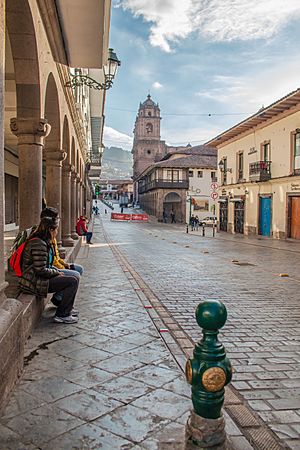
Basílica de la Merced
This church was first built in 1536 but was destroyed by an earthquake in 1650. It was rebuilt by 1675.
It has beautiful cloisters (covered walkways) in the Baroque and Renaissance styles. You can also see colonial paintings and wood carvings.
Inside, there's an amazing gold and gemstone monstrance that weighs 22 kg (48.5 lbs) and is 130 cm (51 inches) tall.
Cusco Cathedral
The first cathedral in Cusco, Iglesia del Triunfo, was built in 1539 on the foundations of the palace of Viracocha Inca. It's now a chapel next to the main cathedral.
The main cathedral was built between 1560 and 1664. It used stone from nearby quarries, and some red granite blocks came from the Saksaywaman fortress.
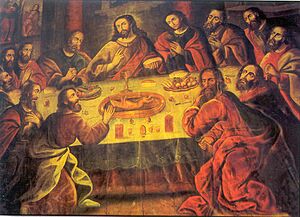
This large cathedral has beautiful interiors with different styles. It also has an amazing collection of colonial goldwork and carved wooden altars.
Cusco developed its own style of painting called the "Cuzco School." The cathedral has many paintings by local artists from that time. One famous painting shows the Last Supper with Jesus and his followers eating guinea pig, a traditional Andean food.
Plaza de Armas de Cusco
This main square was known as the "Square of the warrior" during the Inca Empire. Many important events have happened here, including the Spanish taking control of Cusco.
The Spanish built stone arches around the plaza, which are still there today. The main cathedral and the Church of La Compañía both open directly onto the square.
Iglesia de la Compañía de Jesús
This church was started by the Jesuits in 1576. It was built on the foundations of the Amarucancha, which was the palace of the Inca ruler Wayna Qhapaq. It's considered one of the best examples of colonial baroque style in the Americas.
Its front is carved from stone, and its main altar is made of carved wood covered in gold. It has a valuable collection of colonial paintings from the Cusco School.
Qurikancha and Convent of Santo Domingo
The Qurikancha ("golden place") was the most important temple dedicated to the Sun God (Inti) during the Inca Empire. Old stories say it had a huge solid gold disc with precious stones that represented the Sun God. Spanish writers described a Sacred Garden in front of the temple with golden plants and animals.
The Spanish destroyed the temple when they arrived. Today, only a curved outer wall and some ruins of the inner temple remain.
On top of these Inca foundations, the Spanish built the Convent of Santo Domingo in the Renaissance style. This building is taller than many others in the city.
Inside the convent, there is a large collection of paintings from the Cuzco School.
Getting Around Cusco
Air Travel
Cusco's main airport is Alejandro Velasco Astete International Airport. It has flights to other cities in Peru and some international destinations. It's the second busiest airport in Peru. A new airport, Chinchero International Airport, is being built to connect Cusco directly to North America and Europe.
Train Travel
Cusco is connected by train to cities like Juliaca and Arequipa. From the San Pedro station, you can take a train to the ancient Inca city of Machu Picchu. PeruRail is the main train company that serves Cusco.
Road Travel
You can reach Cusco by road from cities like Puerto Maldonado, Arequipa, and Abancay. The road to Abancay is also the fastest way to get to Lima, though it's a long journey of over 20 hours.
Healthcare in Cusco
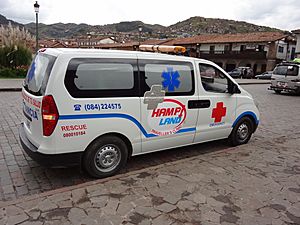
As a major city, Cusco has many hospitals and health centers. These include public hospitals run by the government and several clinics.
Cusco's Sister Cities
Cusco has many "sister cities" around the world, which means they have special friendly relationships:
 Athens, Greece
Athens, Greece Baguio, Philippines
Baguio, Philippines Bethlehem, Israel
Bethlehem, Israel Chartres, France
Chartres, France Copán Ruinas, Honduras
Copán Ruinas, Honduras Cuenca, Ecuador
Cuenca, Ecuador Havana, Cuba
Havana, Cuba Jersey City, United States
Jersey City, United States Jerusalem, Israel
Jerusalem, Israel Kaesong, North Korea
Kaesong, North Korea Kraków, Poland
Kraków, Poland Kyoto, Japan
Kyoto, Japan Mexico City, Mexico
Mexico City, Mexico Moscow, Russia
Moscow, Russia La Paz, Bolivia
La Paz, Bolivia Potosí, Bolivia
Potosí, Bolivia Puebla, Mexico
Puebla, Mexico Rio de Janeiro, Brazil
Rio de Janeiro, Brazil Samarkand, Uzbekistan
Samarkand, Uzbekistan San Miguel de Allende, Mexico
San Miguel de Allende, Mexico Santa Barbara, United States
Santa Barbara, United States Takayama, Japan
Takayama, Japan Tempe, United States
Tempe, United States Xi'an, China
Xi'an, China
Images for kids
-
Mercedarian Friars in the Corpus Christi procession at the Main Square of Cusco. 17th century. Cusco Colonial Painting School. Painting currently located at the Archbishop's Palace of Cusco.
See also
 In Spanish: Cuzco para niños
In Spanish: Cuzco para niños


